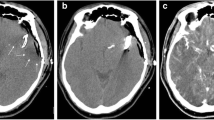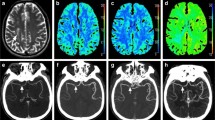Abstract
Objectives
To investigate the feasibility of low-concentration contrast media (LC-CM) in cerebral and cervical dual-energy CT angiography (DE-CTA) using an advanced monoenergetic (Mono+) reconstruction technique.
Methods
Sixty-five consecutive patients prospectively selected to undergo cerebral and cervical DE-CTA were randomised into two groups: 32 patients (63.7 ± 9.7 years) in the high-concentration contrast medium (HC-CM) group with iopromide 370 and 33 patients (60.7 ± 10.8 years) in the low-concentration contrast medium (LC-CM) group with iodixanol 270. Traditional monoenergetic (Mono) and Mono+ images from 40 to 100 keV levels (at 10-keV intervals) and the standard mixed (Mixed, 120 kVp equivalent) images were reconstructed. Subjective image quality parameters included the contrast-to-noise ratio (CNR) and objective image quality parameters were evaluated and compared between the two groups.
Results
The 40-keV Mono+ images in the LC-CM group showed comparable objective CNR (common carotid arteries: 83.7 ± 24.5 vs. 78.1 ± 23.2; internal carotid arteries: 82.2 ± 26.8 vs. 76.8 ± 24.1; middle cerebral arteries: 72.5 ± 24.6 vs. 70.6 ± 19.2; all p > 0.05) and subjective image scores (3.95 ± 0.19 vs. 3.83 ± 0.35; p > 0.05) compared with Mixed images in the HC-CM group.
Conclusion
The Mono+ reconstruction technique could reduce the concentration of iodinated CM in the diagnosis of cerebral and cervical angiography.
Key Points
• Mono+ shows decreased noise and superior CNR compared with Mono.
• The 40-keV Mono+ images show the highest CNR in the LC-CM group.
• The Mono+ reconstruction technique could reduce the concentration of iodinated CM.




Similar content being viewed by others
Abbreviations
- AA:
-
Ascending aorta
- CCA:
-
Common carotid arteries
- CIN:
-
Contrast-induced nephropathy
- CM:
-
Contrast medium
- CNR:
-
Contrast-to-noise ratio
- CTA:
-
Computed tomographic angiography
- DE-CT:
-
Dual-energy CT
- DS-CT:
-
Dual-source CT
- HC-CM:
-
High-concentration contrast medium
- HU:
-
Hounsfield units
- ICA:
-
Internal carotid arteries
- LC-CM:
-
Low-concentration contrast medium
- MCA:
-
Middle cerebral arteries
- Mixed:
-
Standard mixed
- Mono:
-
Traditional monoenergetic
- Mono+:
-
Advanced monoenergetic
- ROI:
-
Region of interest
- SD:
-
Standard deviation
References
Katzberg RW, Barrett BJ (2007) Risk of iodinated contrast material--induced nephropathy with intravenous administration. Radiology 243:622–628
Davenport MS, Khalatbari S, Dillman JR, Cohan RH, Caoili EM, Ellis JH (2013) Contrast material-induced nephrotoxicity and intravenous low-osmolality iodinated contrast material. Radiology 267:94–105
Waikar SS, Liu KD, Chertow GM (2008) Diagnosis, epidemiology and outcomes of acute kidney injury. Clin J Am Soc Nephrol 3:844–861
Silver SA, Shah PM, Chertow GM, Harel S, Wald R, Harel Z (2015) Risk prediction models for contrast induced nephropathy: systematic review. BMJ 351
Nyman U, Bjork J, Aspelin P, Marenzi G (2008) Contrast medium dose-to-GFR ratio: a measure of systemic exposure to predict contrast-induced nephropathy after percutaneous coronary intervention. Acta Radiol 49:658–667
Liu ZZ, Schmerbach K, Lu Y et al (2014) Iodinated contrast media cause direct tubular cell damage, leading to oxidative stress, low nitric oxide, and impairment of tubuloglomerular feedback. Am J Physiol Renal Physiol 306:F864–F872
Kitamura O, Uemura K, Kitamura H, Sugimoto H, Akaike A, Ono T (2009) Serofendic acid protects from iodinated contrast medium and high glucose probably against superoxide production in LLC-PK1 cells. Clin Exp Nephrol 13:15–24
Bae KT, Heiken JP (2005) Scan and contrast administration principles of MDCT. Eur Radiol 15:E46–E59
Cademartiri F, Mollet NR, van der Lugt A et al (2005) Intravenous contrast material administration at helical 16-detector row CT coronary angiography: effect of iodine concentration on vascular attenuation. Radiology 236:661–665
Kanematsu M, Goshima S, Miyoshi T et al (2014) Whole-body CT angiography with low tube voltage and low-concentration contrast material to reduce radiation dose and iodine load. AJR Am J Roentgenol 202:W106–W116
Zhang C, Yu Y, Zhang Z et al (2015) Imaging quality evaluation of low tube voltage coronary CT angiography using low concentration contrast medium. PloS One 10:e0120539
Yu L, Leng S, McCollough CH (2012) Dual-energy CT-based monochromatic imaging. AJR Am J Roentgenol 199:S9–S15
Schneider D, Apfaltrer P, Sudarski S et al (2014) Optimization of kiloelectron volt settings in cerebral and cervical dual-energy CT angiography determined with virtual monoenergetic imaging. Acad Radiol 21:431–436
Apfaltrer P, Sudarski S, Schneider D et al (2014) Value of monoenergetic low-kV dual energy CT datasets for improved image quality of CT pulmonary angiography. Eur J Radiol 83:322–328
Okayama S, Seno A, Soeda T et al (2012) Optimization of energy level for coronary angiography with dual-energy and dual-source computed tomography. Int J Cardiovasc Imaging 28:901–909
Sudarski S, Apfaltrer P, Nance JW Jr et al (2013) Optimization of keV-settings in abdominal and lower extremity dual-source dual-energy CT angiography determined with virtual monoenergetic imaging. Eur J Radiol 82:e574–e581
Grant KL, Flohr TG, Krauss B, Sedlmair M, Thomas C, Schmidt B (2014) Assessment of an advanced image-based technique to calculate virtual monoenergetic computed tomographic images from a dual-energy examination to improve contrast-to-noise ratio in examinations using iodinated contrast media. Invest Radiol 49:586–592
Meier A, Wurnig M, Desbiolles L, Leschka S, Frauenfelder T, Alkadhi H (2015) Advanced virtual monoenergetic images: improving the contrast of dual-energy CT pulmonary angiography. Clin Radiol 70:1244–1251
Albrecht MH, Scholtz JE, Husers K et al (2016) Advanced image-based virtual monoenergetic dual-energy CT angiography of the abdomen: optimization of kiloelectron volt settings to improve image contrast. Eur Radiol 26:1863–1870
Martin SS, Albrecht MH, Wichmann JL et al (2017) Value of a noise-optimized virtual monoenergetic reconstruction technique in dual-energy CT for planning of transcatheter aortic valve replacement. Eur Radiol 27:705–714
Beeres M, Trommer J, Frellesen C et al (2016) Evaluation of different keV-settings in dual-energy CT angiography of the aorta using advanced image-based virtual monoenergetic imaging. Int J Cardiovasc Imaging 32:137–144
Leng S, Yu L, Fletcher JG, McCollough CH (2015) Maximizing iodine contrast-to-noise ratios in abdominal ct imaging through use of energy domain noise reduction and virtual monoenergetic dual-energy CT. Radiology 276:562–570
Albrecht MH, Trommer J, Wichmann JL et al (2016) Comprehensive comparison of virtual monoenergetic and linearly blended reconstruction techniques in third-generation dual-source dual-energy computed tomography angiography of the thorax and abdomen. Invest Radiol 51:582–590
Riffel P, Haubenreisser H, Meyer M et al (2016) Carotid dual-energy CT angiography: Evaluation of low keV calculated monoenergetic datasets by means of a frequency-split approach for noise reduction at low keV levels. Eur J Radiol 85:720–725
Mangold S, Cannao PM, Schoepf UJ et al (2016) Impact of an advanced image-based monoenergetic reconstruction algorithm on coronary stent visualization using third generation dual-source dual-energy CT: a phantom study. Eur Radiol 26:1871–1878
Sigal-Cinqualbre AB, Hennequin R, Abada HT, Chen X, Paul JF (2004) Low-kilovoltage multi-detector row chest CT in adults: feasibility and effect on image quality and iodine dose. Radiology 231:169–174
Zhang WL, Li M, Zhang B et al (2013) CT angiography of the head-and-neck vessels acquired with low tube voltage, low iodine, and iterative image reconstruction: clinical evaluation of radiation dose and image quality. PloS One 8:e81486
Kayan M, Demirtas H, Turker Y et al (2016) Carotid and cerebral CT angiography using low volume of iodinated contrast material and low tube voltage. Diagn Interv Imaging 97:1173–1179
Luo S, Zhang LJ, Meinel FG et al (2014) Low tube voltage and low contrast material volume cerebral CT angiography. Eur Radiol 24:1677–1685
Almutairi A, Sun Z, Poovathumkadavi A, Assar T (2015) Dual energy CT angiography of peripheral arterial disease: feasibility of using lower contrast medium volume. PloS One 10:e0139275
Yuan R, Shuman WP, Earls JP et al (2012) Reduced iodine load at CT pulmonary angiography with dual-energy monochromatic imaging: comparison with standard CT pulmonary angiography--a prospective randomized trial. Radiology 262:290–297
Delesalle MA, Pontana F, Duhamel A et al (2013) Spectral optimization of chest CT angiography with reduced iodine load: experience in 80 patients evaluated with dual-source, dual-energy CT. Radiology 267:256–266
Meier A, Higashigaito K, Martini K et al (2016) Dual energy CT pulmonary angiography with 6g iodine-A propensity score-matched study. PLoS One 11:e0167214
Fu W, Marin D, Ramirez-Giraldo JC et al (2017) Optimizing window settings for improved presentation of virtual monoenergetic images in dual-energy computed tomography. Med Phys
De Cecco CN, Caruso D, Schoepf UJ et al (2016) Optimization of window settings for virtual monoenergetic imaging in dual-energy CT of the liver: A multi-reader evaluation of standard monoenergetic and advanced imaged-based monoenergetic datasets. Eur J Radiol 85:695–699
Caruso D, Parinella AH, Schoepf UJ et al (2017) Optimization of window settings for standard and advanced virtual monoenergetic imaging in abdominal dual-energy CT angiography. Abdom Radiol (NY) 42:772–780
Saba L, Mallarin G (2009) Window settings for the study of calcified carotid plaques with multidetector CT angiography. AJNR Am J Neuroradiol 30:1445–1450
Saba L, Mallarini G (2008) MDCTA of carotid plaque degree of stenosis: evaluation of interobserver agreement. AJR Am J Roentgenol 190:W41–W46
Weiss J, Notohamiprodjo M, Bongers M et al (2017) Effect of noise-optimized monoenergetic postprocessing on diagnostic accuracy for detecting incidental pulmonary embolism in portal-venous phase dual-energy computed tomography. Invest Radiol 52:142–147
Martin SS, Wichmann JL, Weyer H et al (2017) Endoleaks after endovascular aortic aneurysm repair: Improved detection with noise-optimized virtual monoenergetic dual-energy CT. Eur J Radiol 94:125–132
Martin SS, Wichmann JL, Scholtz JE et al (2017) Noise-optimized virtual monoenergetic dual-energy CT improves diagnostic accuracy for the detection of active arterial bleeding of the abdomen. J Vasc Interv Radiol 28:1257–1266
Funding
This study has received funding by the Tianjin Research Program of Application Foundation and Advanced Technology (grant 14JCZDJC57000) and National Natural Science Foundation of China (grant 81301217).
Author information
Authors and Affiliations
Corresponding author
Ethics declarations
Guarantor
The scientific guarantor of this publication is Dong Li.
Conflict of interest
The authors of this manuscript declare relationships with the following companies: Gu Jun is on the speakers' bureau of Siemens Healthineers, Computed Tomography division. The other authors of this manuscript declare no relationships with any companies whose products or services may be related to the subject matter of the article.
Statistics and biometry
No complex statistical methods were necessary for this paper.
Informed consent
Written informed consent was waived by the Institutional Review Board.
Ethical approval
Institutional Review Board approval was obtained.
Methodology
• prospective
• case-control study
• performed at one institution
Electronic supplementary material
ESM 1
(DOCX 136 kb)
Rights and permissions
About this article
Cite this article
Zhao, L., Li, F., Zhang, Z. et al. Assessment of an advanced virtual monoenergetic reconstruction technique in cerebral and cervical angiography with third-generation dual-source CT: Feasibility of using low-concentration contrast medium. Eur Radiol 28, 4379–4388 (2018). https://doi.org/10.1007/s00330-018-5407-1
Received:
Revised:
Accepted:
Published:
Issue Date:
DOI: https://doi.org/10.1007/s00330-018-5407-1




